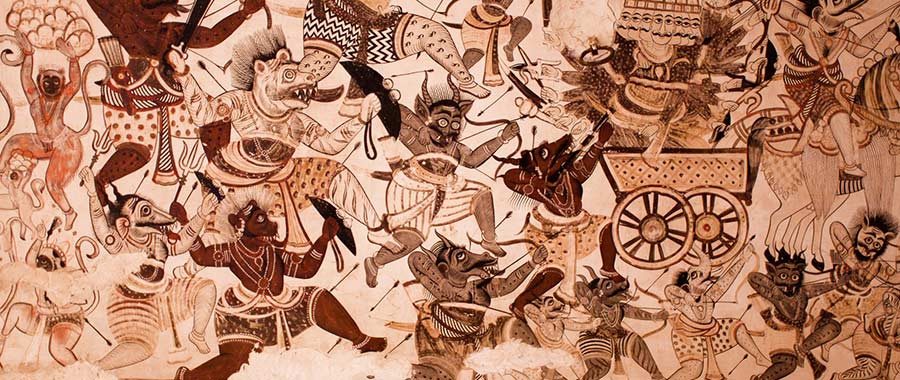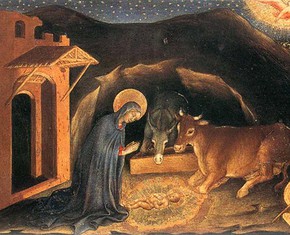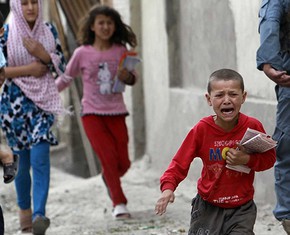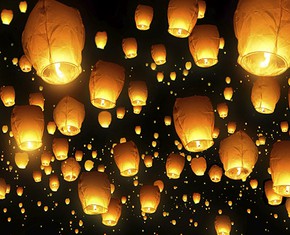The views expressed in our content reflect individual perspectives and do not represent the authoritative views of the Baha'i Faith.
Triumph of good over evil is generally regarded as a good thing. Yet how that triumph is brought about, however, makes all the difference.
There’s the old saying, “Might makes right.” But if that “might” is wrong (as the means to an end), then how can “Wrong make right”? Perhaps the saying should be turned on its head, where: “Right makes might.” Not eloquent, but you get the point.
Better that this world be transformed through a change of consciousness, not through force. If so, that creates a problem: How do we understand Baha’u’llah as the messianic fulfiller of the Hindu prophecies regarding the Kalki avatar, especially if Kalki is a warrior, not a peacemaker?
In Part I, we introduced the book of the Hindu apocalypse, known as the Kalki Purana. The text has been explained as a cosmic conflict between the forces of good and evil. In that sense, the Kalki Purana is a fairly typical apocalyptic narrative.
The Kalki Purana narrates several graphic battles. These are somewhat quaint and imaginative. They are also quite brutal and bloody. This would probably not have offended readers or hearers in medieval India.
On a positive note, Kalki’s mission to banish evil is noble and praiseworthy:
Lord Kalki, the master of the universe, is decorated with transcendental ornaments and equipped with a bow and arrows, so that it appears as if he is about to destroy all the suffering and sins of this material world. – Kalki Purana 23:3.
In Chapter 24, “Prayers of Susanta: Lord Kalki Marries King Sasidhvaja’s Daughter,” the following is stated regarding the spiritual mission of Lord Kalki:
Those who always chant Your holy names, which destroy the contamination of Kali, removes the fear of material existence, and enables one to develop transcendental qualities, even though undergoing material miseries at present, will never again have to accept a material body.
Because of Your appearance within this world, the prestige of the devotees has been reinstated, the brahmanas once again engage in their ritualistic performances, the demigods feel secure, Satya yuga will soon commence, religious principles are being obeyed, and the influence of Kali has slackened. – Ibid., 24:7–8.
Here, after Lord Kalki’s victory, the former power and prestige of Hindu Brahmins (priests) are restored, and the Hindu religion regains ascendancy, after it had lapsed and declined. In other words, the Kalki Purana envisions the renewal and resurgence of Hinduism.
In order for these Hindu prophecies to be considered fulfilled by Baha’u’llah, the concept of religion (here, Hinduism) needs to be universalized, free of all parochial and sectarian boundaries. At the very least, in a world where peace reigns, there should be peace among religions.
Here’s the aftermath, the climax, the happy result of Lord Kalki’s triumphs over the forces of evil:
The demigods resumed moving about freely, bestowing benedictions upon their worshipers. The fields became filled with food grains as prosperity reigned throughout the world. Everyone became happy and well-nourished. Cheating, stealing, lies, duplicity, natural disasters, and disease vanished from the face of the earth.
The brahmanas resumed studying the Vedas, the ladies performed religious rituals, executed holy vows, and participated in the sacrificial performances of their husbands. In this way, the ladies remained chaste and pious. The ksatriyas engaged themselves in the performance of fire sacrifices. The vaisyas worshiped Lord Hari with great pomp, and the sudras maintained themselves by serving the higher three classes of men. By serving the brahmanas, the sudras received the opportunity of hearing the glories of Lord Hari and taking part in His worship. – Ibid., 28:32–33.
Here, Hinduism is restored and revitalized. Yet note that the caste system remains very much intact. No religious or social reform is in view here. (Now, the government of India has outlawed the old caste system, and rightly so.)
Here’s another problem: If Lord Kalki has appeared as Baha’u’llah, then why is there still “cheating, stealing, lies, duplicity, natural disasters, and disease” in the world today?
Baha’is believe that the short answer is, by the power of the teachings and laws of Baha’u’llah, the ills of society will be overcome. This will come about as the result of human will and effort—divinely inspired, of course—and not as the result of some sudden, miraculous occurrence.
There is, of course, a happy ending to the Kalki Purana:
Lord Kalki continued to reside in the village of Sambhala, along with His brothers, sons, other relatives, and associates, for one thousand years. – Ibid., 32:2.
The point I’d like to make here is that the Kalki Purana is a product of its time and place. The Kalki Purana is a utopian vision of an ideal society from a decidedly Hindu perspective. This vision of the future is a projection of an idealized past.
There is no way in which Baha’u’llah fulfills this aspect of the Kalki narrative, wherein Lord Kalki, “takes pleasure in sporting with His consorts.” (Kalki Purana 32:24.) Of course, if read allegorically—much like the biblical Song of Solomon—then perhaps this narrative could be understood and appreciated in a radically spiritualized way.
In Chapter 33, “The Demigods Arrive at Sambhala: The Disappearance of Lord Kalki,” the Hindu messiah, Lord Kalki, departs from this mortal world, having handed over the rule of the kingdom to his four sons. On seeing his apparent death, Lord Kalki’s two wives burn themselves alive, in order to join their husband in the spiritual realm:
Padmavati and Rama saw Lord Kalki’s transcendental form as if devoid of life and realizing this to be an illusory display of the external energy, although greatly astonished, they entered fire so as to rejoin their husband in His eternal abode. – Ibid., 33:26.
This is Sati (or Suttee), the practice of “widow burning.” This ancient Hindu custom in India is one in which the widow immolates herself on her dead husband’s funeral pyre, to be burnt to ashes in a devotional act of conjugal cremation. This practice was outlawed in India by the British since 1829, and has been banned ever since.
Drawing attention to such practices, as portrayed in this medieval narrative, is not meant to scandalize the Kalki Purana, but to demystify the text so that it can be properly viewed as a product of its time and place.
Speaking of the new spiritual and social laws revealed by Baha’u’llah, the Universal House of Justice proclaims:
In its affirmation of the validity of the great religions of the past, the [Most Holy Book] reiterates those eternal truths enunciated by all the Divine Messengers: the unity of God, love of one’s neighbour, and the moral purpose of earthly life. At the same time it removes those elements of past religious codes that now constitute obstacles to the emerging unification of the world and the reconstruction of human society. – Introduction, in The Most Holy Book, p. 2 (emphasis added).
You May Also Like
Comments

















(Tablets p. 155)
Baha'u'llah is the Messenger of peace: "Ye have been forbidden in the Book of God to
engage in contention and conflict, to strike another, or to commit similar acts whereby hearts and souls may be saddened... "
(Baha'u'llah, The Kitab-i-Aqdas, p. 72)